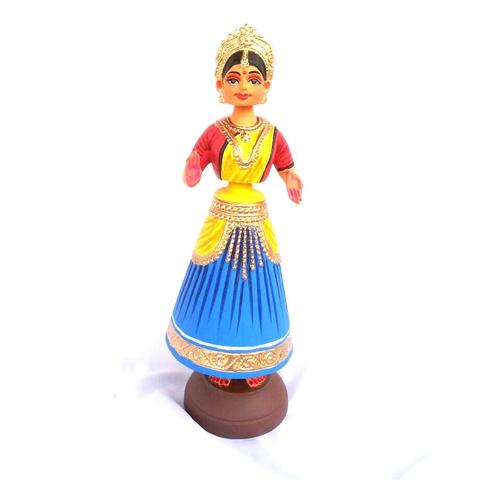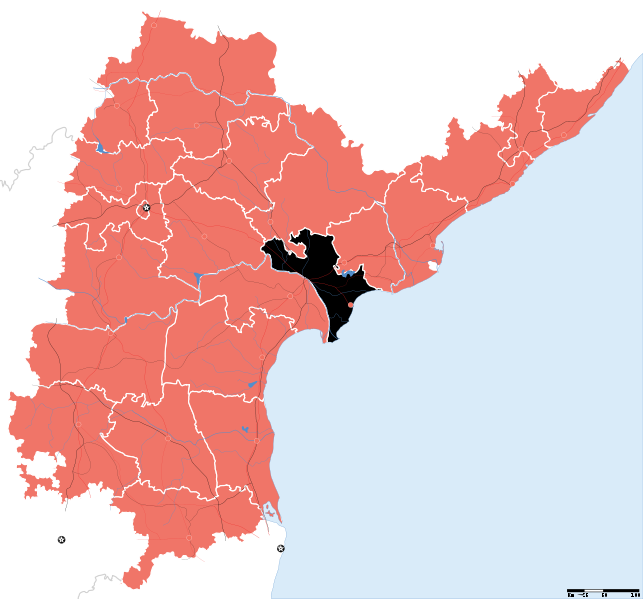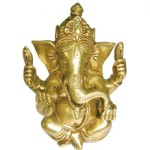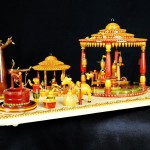Continuing our Series on Arts & Crafts is the native ancient style of wooden toys known to all Telugus. Appreciated by Andhraite and non-Andhraite , young and old alike is that iconic handicraft we all grew up with: Kondapalli Bommalu.
History
Kondapalli an important town near Vijayawada, in Krishna District. Meaning ‘village of hills’, it is also a village of toys. 16 kilometres from Bezawada, it is celebrated in story and song for its famous fort, immortalised during the reign of the Reddi Rajulu.
Around 500 years old, if not older, this art is credited to and preserved by a community known as nakarshalu (though by some they also called ‘Arya Kshatriyalu’).
There is reference to this group in the “Brahmanda Purana”. This community claims its origin to Muktharishi, who was endowed with skills in arts and crafts by Lord Shiva. These chitrakaras claim that it was their ancestors who sculpted the numerous sculptures like the garuda, nandi, simha and the vahanas in the many temples in Andhra Pradesh.[2]
It is claimed that this art was brought by migrants from Rajasthan, though these claims still need to be verified by history. One account lends credence to the theory.
In the 16th century, Anavema Reddy invited around 10-12 families, all wooden handicrafts specialists from Rajasthan, to his court, says Nageshwar Rao, 37, a toy-maker. “All these families from the Nakarshalu community migrated to Kondapalli.” The Reddy kings, impressed by their skill, patronised the artisans and asked them to stay there forever. [7]
Characteristics
 Made primarily from a soft wood known as Tella Poniki, which is found in large numbers around Kondapalli itself, these toys have not only become characteristic of Andhra, but have a number of standout characteristics.
Made primarily from a soft wood known as Tella Poniki, which is found in large numbers around Kondapalli itself, these toys have not only become characteristic of Andhra, but have a number of standout characteristics.
Distinct from their Telugu cousins, Etikoppaka Toys, these Kondapalli carvings carry with them a special significance during Sankranthi and Dasara. They are displayed in bommalakolavu or kollu. Both vahanas and veritable vigrahas of pauranic figures are depicted and showcased during these festivals. They are used to enshrine and enact the various stories contained in our epics.
Prices of these toys range from Rs. 15 to Rs. 800 and the Corporation is offering 10 per cent discount on the purchase during the expo. [5]
At the high end, many toys even reach 5,000 rupees. Themes from Dasavatara and Hitopadesa are common. Nevertheless, the ambari elephant and the kuchipudi dancers remain the most iconic favourites. And the appeal is universal. These craftsmen have a unique place in the hearts and minds of Telugus, young and old alike.
Equipped with ‘bavudari’, ‘palapa chekka’ and ‘aakurai’, generations of these toymakers have managed to bring a smile on the faces of little kids across the world with their pieces of art. [3]
Process
Unlike most modern toys, Kondapalli bommalu use almost all natural ingredients in the process. Tools come in various shapes and sizes and are developed by the craftsmen.
The wood is treated to a slow heating process to dry its moisture content. The limbs of the toys are carved separately and later joined to the body. The essential carving tools are axe, chisel, hammer and drill. [5]
Glue consisting of tamarind paste, lapum, and sawdust is used to assemble them.
This tamarind paste is called makh. Batana (cooked tamarind seed paste) is then rubbed on it along with resin from the tumma tree.Gold and silver foil used to be added for ornamentation. Although water colours, vegetable dyes, and oil paints are now used, traditional rangulu relied on stones, herbs, various gums and other bases. Even the paint brush comes from goat hairs, demonstrating the stress on organic materials.
Ladies are also an integral part of the process, much of the artistry of these dolls being attributed to their skill with a brush. Finished products are often given a coating of enamel paint to enhance their sheen.
Future
#Kondapalli Toy has emerged as d first hand-made #toy from Andhra Pradesh to be granted a #GI #tag in 2007 #vijayawada #wooden white sander. pic.twitter.com/qjBM5u4FYK
— AndhraPradeshTourism (@APTDCofficial) April 11, 2017
Kondapalli Bomma retains an international reputation and is frequently purchased by tourists during their travels in our region. It received a Government sanctioned Geographical Indication in 2007-2008, thereby crediting this handicraft to Andhra. Despite this accreditation, the future of this iconic tradition remains in question.
“Over the centuries, the skill moved beyond the Nakarshalu community, and it is no longer a caste-specific occupation. Members of various communities and castes, including Padmashali, Kamsali, Vishwabrahmin, now work in the Kondapalli toy industry. Records of the Mutually Aided Cooperative Society (MACS), established in 2002 by the artisans, show that in February 2017, of the 229 toy-makers in the village, 107 are men and 122 women. Of these, 53 are Dalits, 128 are from Other Backward Classes, 26 are Muslim, and 22 are from other, landed castes.” [7]
As with many traditional Arts and Crafts of United Andhra, Kondapalli Toys are also on the brink. The community that preserves this ancient art is finding itself in difficult financial straits. 50 families live in Bommala Colony in Kondapalli, fulfilling large orders on the infrequent occasions they materialise. Dependent upon Lepakshi outlets and various art exhibitions, they require reliable and equitable distribution channels to maintain their livelihood and craft.
At the annual Lepakshi Expo, the turnover is around 3 Lakh rupees. While there are cooperatives supported by Lanco group and various efforts ( such as this and this and this and this) to market these products, society-at-large must come together to help these traditional workers compete with the global market of competitors with products sourced from China and elsewhere.
Though there have been some redesign drives to both update the toys and their relevance to the contemporary market, much more work needs to be done in this regard.
The nouveau riche of Andhra again have an opportunity to step and support these workers and protect our common heritage.
In the olden days, Kondapalli artists received patronage from the local rulers. But today these artisans are neglected due to the advent of mechanised toys. Many artisans have given up their profession and are seeking other lucrative jobs. Though the government is trying to rehabilitate this art form, it is up to us to encourage it. It is our duty to do so. [2]
Click here to Buy Kondapalli Toys Today!!!
References:
- Gajrani, S. History, Religion, and Culture of India. Vol 2.Delhi: Isha Books. 2004
- https://web.archive.org/web/20160127053030/http://www.thehindu.com/thehindu/yw/2003/06/21/stories/2003062100470300.htm
- http://timesofindia.indiatimes.com/city/hyderabad/Toying-with-heritage-No-heir-to-Kondapallis-amazing-art/articleshow/47336094.cms
- http://www.ipindia.nic.in/writereaddata/Portal/News/ 283_1_REGISTRATION_DETAILS_OF_GI_TILL_DATE_March_2012_Till_Date.pdf
- https://web.archive.org/web/20140626104254/http://www.hindu.com/2011/01/12/stories/2011011261670200.htm
- http://www.deccanherald.com/content/379894/tales-kondapalli-toys-narrate.html
- https://ruralindiaonline.org/articles/no-longer-a-toy-story/
- http://www.lepakshihandicrafts.gov.in/blog/kondapalli-toys.html
- http://www.thehindu.com/features/kids/know-all-about-the-kondapalli-toys/article7611347.ece








Excellent. Long long ago these toys were liked by one and all. But due encroachment of Chainees market,patronage for these toys is low.we all have to encourage with full spirits to give a fillip to this industry.